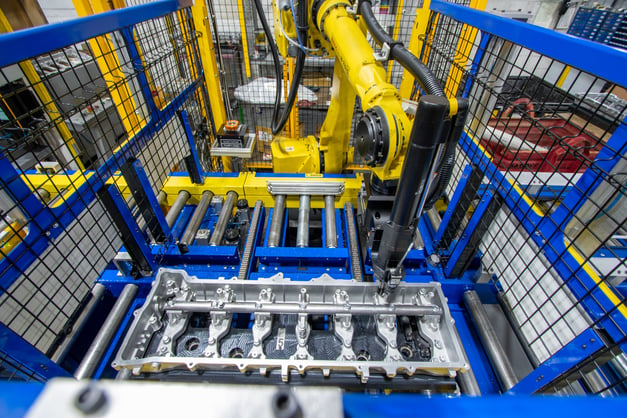New technological innovations are introduced every year, but if you keep your eyes open, you’ll see shifts that can turn into trends in the CNC machining industry.
When you’re aware of these trends, you can pick and choose which may affect your CNC machine shop or industrial business the most, and address them as needed. Let’s explore the top 8 trends (as we see them) that could drive your success as we continue on through 2025.
1. Optimizing Automation & Robotics
Automation and robotics continue to be used more and more in CNC machining. The CNC technologies that perform automated tasks are more intuitive than ever. Many tools work just like a smartphone, with a basic, straightforward design that feels like other tech in people’s lives, meaning they don’t all require expertise and extensive training.
Using CNC machining technology advancements has always given companies a way to set themselves apart. There are opportunities to machine complex pieces using robotics that couldn’t have been done efficiently before. In fact, it’s now a disadvantage to continue with manual labor when a cost-effective option exists.
However, with an overall softening in the market and hiring constraints, CNC machine shops are looking for ways to optimize the technologies they’ve already invested in. At Stecker Machine Company, we’re asking how we can make our robotic cells, equipment, and workforce more efficient.
2. Addressing the Need for Manufacturing Employees
While talent shortages have eased for some manufacturing sectors, it remains a #1 focus for many CNC facilities. We still want to bring people in at Stecker Machine Company, but our main focus is on building a strong culture, professional development, cross-training, and upskilling. We want to empower them and find ways to help them advance through their careers.
Addressing the manufacturing employee shortage is no longer about just filling positions with warm bodies. Helping workers grow their CNC careers is a big focus for 2025 and beyond. CNC companies that want to get ahead will need to leverage the collective knowledge of those on the shop floor and seek their input on processes and potential efficiency gains. Empowering them to be a part of the solution is key to a stronger culture, better retention, and easing the labor shortage.
3. Combatting Rising Costs
Skilled manufacturing employees aren't just tough to find, it’s expensive. Salaries, insurance, benefits, training, etc. … these expenses add up quickly. And, while the responsibility to maintain quality should ultimately fall on humans, there’s a need to ensure technology upgrades and maintenance which add to the costs of doing business.
Supply chain issues have stabilized but inflation is still present, making raw materials and transport more expensive. It will be a challenge to grow margins in the CNC industry, stressing the need to develop robust processes and upfront design. Top CNC machine shops know that creating a smooth machining process is especially critical for the consistent production of complex parts.
4. Shifting Economy & Target Markets
While there is always uncertainty about the economy, there is now some certainty within the political climate after several years. With the recent administration changes, there’s a bit more understanding of the market moving forward and where the industrial sector needs to focus.
Overall, it’s believed that the industrial sector is on an upswing and positioned well for the future. The electric vehicle market continues to grow steadily but isn’t seeing the surge it had in previous years. The agriculture and recreational vehicle market has slowed but is believed to be cyclical.
5. Steady Path Toward Sustainability
Sustainability has routinely made the list of annual trends in CNC machining. So much so that it’s becoming less of a focus. That’s not because manufacturers don’t care about sustainability but because most have already put measures in place to address any issues.
CNC shops are required to hit various KPIs related to sustainability: process efficiency, material re-use recycling, greenhouse gas emissions, and other corporate social responsibility issues. It’s simply become a way of doing business now rather than a trend to pursue.
Instead, many sustainability efforts are shifting toward community sustainability. CNC companies that have strong ties to their communities not only care about creating a cleaner and more equitable world for the places they live and work, but they also become more attractive to potential recruits.
6. Resourcing Globally
The industry will continue to feel the effect of CNC machined parts being resourced from China and elsewhere (mainly Mexico and India). Even though U.S. markets have stabilized and backlogs are reduced, the costs keep rising faster than other countries.
Stateside CNC companies need to find ways to mitigate the risks of global competition by exploring overseas pricing for raw materials and other components while still ensuring the highest quality. Costs will continue to increase and may become a tug of war with customers to ensure a win-win scenario.
7. A Demand for Higher Quality
Supply chain issues have been a major challenge in recent years and some manufacturers were forced to settle for lower-quality parts because they were their only option to keep production lines running. Stecker Machine was able to maintain its high standards despite the challenges.
Moving forward, CNC shops that focus on quality and value-added services like engineering and design for manufacturability (DfM) will stand out among commodity machining. Expectations are shifting, with the industry slowly swinging back toward “gold level” customer service which was common in pre-pandemic years.
Being able to meet world-class standards and implement a high level of quality control are skills every CNC machine shop needs to compete.
8. More Artificial Intelligence Integration
Throughout the CNC machining industry, artificial intelligence is a bit more on the fringe than some others. However, its capabilities are so impressive overall that every facility needs to keep an eye on ongoing advancements.
2025 may prove to be a breakout year for AI throughout CNC machining. That’s not to imply that AI isn’t already being used. Some non-production tasks within a company — communication, marketing, processes, etc. — use AI tools regularly.
Beyond 2025
Looking beyond 2025, Stecker’s vision is to sustain a path of conservative, steady growth — to not overextend ourselves, to perform technology upgrades or a potential expansion, and to continue investing in our people.
Ready to get a big-picture view of CNC machining? Check out Stecker Machine’s CNC Machine Shop Guide, a free and comprehensive resource you can use to help determine the right time to work with a custom CNC shop. Download it today and reach out to our helpful team with questions.







